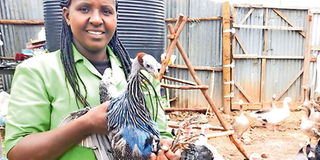Birds that lay a golden pay

Margaret Njeri Maina in her eighth-acre farm near Kiriri Women’s University on the outskirts of Nairobi. She keeps ornamental birds in the farm. PHOTO | SAMMY WAWERU | NMG
What you need to know:
- Margaret, whose eighth-acre farm is near Kiriri Women’s University on the outskirts of Nairobi, specialises in selling Kuroiler chicks, alongside the beauties.
- Margaret, 36, discloses that she purchased two male and two female mallards at Sh2,000 each. She also bought two female guinea fowls and a male, each at Sh800, from different sources.
- She has three incubators, with a capacity of hatching 2,112, 1,056 and 500 eggs. According to the farmer who was initially in the printing business, a mallard lays an average of 20 eggs per month, which she hatches and sells – from day-old to week-old chicks for Sh500.
- She offers the birds commercial feeds, which she says are expensive, with a 50kg sack of chick mash going for Sh2,700 and layers at Sh2,350, but she cuts down the cost by giving them left-over food and allowing them to free-range.
When Margaret Njeri Maina started rearing ornamental birds, the idea was to have variety on her farm — Gratia Poultry Ltd.
But the beautiful birds have turned to be her major source of income, enabling the farmer expand her agribusiness.
Margaret, whose eighth-acre farm is near Kiriri Women’s University on the outskirts of Nairobi, specialises in selling Kuroiler chicks, alongside the beauties.
“I went for ornamental birds because they always look gorgeous. I rear 60 of them, mainly guinea fowls, mallards and turkeys,” says the farmer, who also keeps geese and doves
She went into poultry farming in 2016, investing Sh15,000 from her savings, after visiting various farms for knowledge and realising birds are worth the time as they have ready market.
“I have 200 Kuroiler hens and 50 cocks. I hatch eggs using incubators and sell the chicks. For ornamental birds, which came in 2017, I began with two geese, which were hatched from five eggs bought at a cost of Sh200 each. I got the eggs from different sources to avoid inbreeding,” she recalls.
She later introduced turkeys that she bought five at Sh2,000 each from a farmer who wanted to clear the flock.
“I consumed three and remained with a tom and a hen for breeding,” she explains, adding that turkey eggs and meat are so tasty.
Mallards — the beautiful ducks with a green head and purple feathers — and guinea fowls, which are her number one selling birds, followed.
Margaret, 36, discloses that she purchased two male and two female mallards at Sh2,000 each. She also bought two female guinea fowls and a male, each at Sh800, from different sources. She later introduced doves for the fun of it.
Since then, her farm has been growing, enabling her to hatch and sell up to 7,000 chicks every week.
“I sell the Kuroiler chicks to farmers from between Sh80 and Sh100 depending on the numbers bought for day-olds,” says Margaret, who has 12 geese, 15 mallards 11 turkeys, 15 doves, and seven guinea fowls.
Customers who buy her chicks are the same ones who go for the ornamental birds whenever they visit her farm.
DISEASE TOLERANT
“They admire the birds because they are attractive. That way, I have managed to grow the project. Market for the Kuroilers and ornamental birds is insatiable,” says the farmer, who holds an advanced Diploma in Computing and Information Processing.
She has three incubators, with a capacity of hatching 2,112, 1,056 and 500 eggs. According to the farmer who was initially in the printing business, a mallard lays an average of 20 eggs per month, which she hatches and sells – from day-old to week-old chicks for Sh500.
“I have never mastered the guinea fowls’ laying pattern, but they perform well during cold season as compared to the hot season. Each guinea fowl lays about 15 eggs a month and I sell a day-old at Sh1,000.”
Geese are slightly poor in laying, offering 20 to 40 eggs a year, but are good in hatching and brooding, says the farmer, adding they are also good for the security of the farm.
Apart from geese, which sit on their eggs, the rest of the birds’ eggs are hatched in incubators. In a year, a turkey lays about 100 eggs, with Margaret selling each poult at Sh1,000.
“I sell all ornamental birds in pairs. Mallards and guinea fowls go for Sh5,000 per pair and turkey and geese at Sh10,000.”
She offers the birds commercial feeds, which she says are expensive, with a 50kg sack of chick mash going for Sh2,700 and layers at Sh2,350, but she cuts down the cost by giving them left-over food and allowing them to free-range. “They also enjoy vegetables,” states Margaret, who has employed three workers.
According to her, almost half of the money she generates goes to running the project; buying food, labour and treatment.
Margaret says ornamental birds are disease-resistant. But Okuta Ngura, the founder and owner of Ngura Poultry Care, an organisation offering poultry services, says common challenges in birds include chronic respiratory disease, coccidiosis, Newcastle and infectious coryza, which calls for vaccination and treatment.
Parasites that affect the birds include fleas, lice and tapeworms. Mites, ticks and roundworms are also common. To curb them, one should maintain high standards of hygiene in the cages.
Margaret keeps various records, including those of clients, for follow up purposes.
To keep ornamental birds, one needs a permit from the Kenya Wildlife Service, at a fee of Sh1,500 per year after convincing the agency that you can properly take care of the birds.





